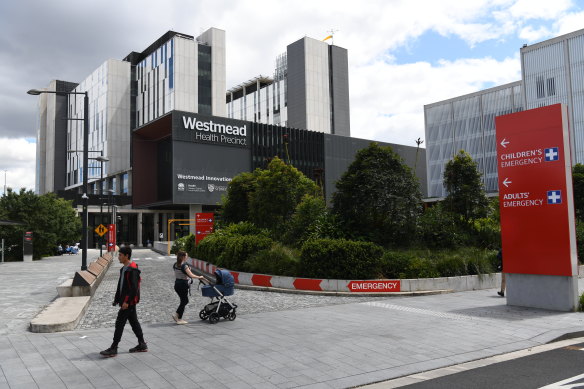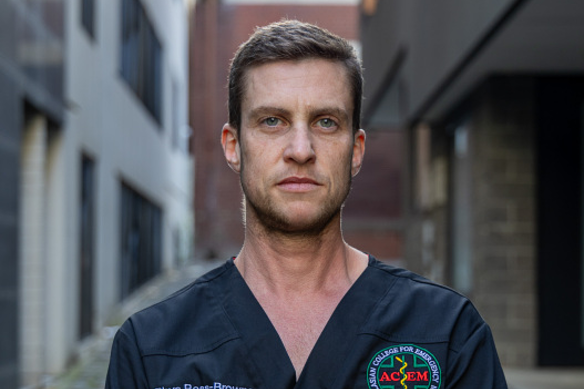By Angus Thomson and Megan Gorrey
Patients at two of the state’s busiest hospitals are spending at least 45 minutes longer in emergency departments than a year ago as new figures reveal almost one in every 10 patients in NSW leaves without completing their treatment.
NSW Health Minister Ryan Park on Tuesday warned the “unprecedented pressure” burdening the state’s hospital emergency departments would probably worsen as the flu season intensified in June.

The emergency department at Westmead Hospital, where patients are spending an hour longer on average than the same time last year. Credit: Dean Sewell
At Westmead Hospital, the median time between arriving at and leaving the emergency department blew out to six hours and 22 minutes between January and March – an hour longer than the same three-month period last year. Only one in three patients left within four hours.
The median time between arriving at and leaving the emergency department at Royal North Shore Hospital jumped 46 minutes to four hours and 40 minutes – an hour longer than the state average of three hours and 38 minutes.
A Northern Sydney Local Health District spokeswoman said the hospital had continued to see a rising number of people in the emergency department.
The 22,168 patients who visited in the first quarter of the year represented a 3 per cent jump from the same period last year – an increase the spokeswoman said could be largely attributed to patients presenting with less serious and non-life-threatening conditions.
“The majority of patients (67.5 per cent) started treatment on time which is significantly better than the average for hospitals of a similar size in NSW (57.5 per cent),” the spokeswoman said.
Westmead Hospital general manager Jenelle Matic said the number of people attending the emergency department in the first three months of the year had jumped 7.4 per cent, or 1413 visits, from the same period in 2023 – a record high for the hospital.
She said the hospital was facing “unprecedented demand for emergency care, with record attendances and record numbers of seriously unwell patients presenting to our emergency departments”.
“During busy times, those with less urgent conditions will experience longer wait times when there are large numbers of seriously unwell patients being prioritised for emergency care,” Matic said.
Of 810,201 visits to NSW emergency departments between January and March, more than 74,000 patients left either before or during their treatment – almost 11,000 more than the same quarter last year.
While most of those patients had less urgent illnesses and injuries, emergency staff scrambled to resuscitate 6677 “triage 1” patients and care for an additional 123,895 “triage 2” patients needing treatment within 10 minutes.
Both numbers, representing the most gravely ill patients, were the highest since the Bureau of Health Information began taking records in 2010.
Dr Rhys Ross-Browne, a Sydney emergency doctor and the NSW chair for the Australasian College for Emergency Medicine, said emergency staff were overwhelmed and he could understand why less urgent patients would choose to leave rather than wait hours in emergency department corridors and overflow rooms.
“Patients are not receiving the kind of timely care in the appropriate treatment space that they should be and I can fully empathise with them getting frustrated and deciding that they’re not going to stay,” he said. “As clinicians, it’s really hard for us – we want to give great care … but we just can’t keep up. We have a finite capacity, really, and that capacity is continuously getting inundated by record presentations.”

Dr Rhys Ross-Browne.
While the number of less urgent presentations also rose, it was not at the same rate as the most serious categories.
Australian Medical Association (NSW) president Dr Kathryn Austin said this showed the argument that increased waiting times were due to less urgent patients was “not borne out in the data”.
“These figures should be a wake-up call to the government that the system is at breaking point. It is the patients of NSW who will continue to suffer, and at increasing rates.”
Hospital woes to worsen as flu cases soar
Park said the state’s health and hospital systems were facing “unprecedented pressure”, warning the burden would probably worsen as the winter flu season worsened in June.
“I can’t stress enough at the moment the pressure that is on our health and hospital system,” Park said on Tuesday.
About 10,000 people sought care in emergency departments in NSW on Monday, he said.
Park attributed this “very, very significant number of presentations … the likes [of which] we haven’t seen for some time” to an early start to the flu season, an uptick in COVID-19 cases and high rates of respiratory syncytial virus (RSV).
“I’m concerned about what the next few weeks are likely to look like as we head into peak flu season.
“I’m encouraging people to make sure that, wherever possible, if they don’t need to be in our emergency departments, to please look for those other avenues we have in place. We want to keep emergency departments for emergencies.”
Park said he was talking to federal Health Minister Mark Butler and the Commonwealth about challenges patients faced accessing GPs and bulk-billing.
“We’ve been very pleased that we’ve been able to get some additional urgent care centres in place, but we need to make sure bulk-billing is sustainable,” he said.
Start the day with a summary of the day’s most important and interesting stories, analysis and insights. Sign up for our Morning Edition newsletter.